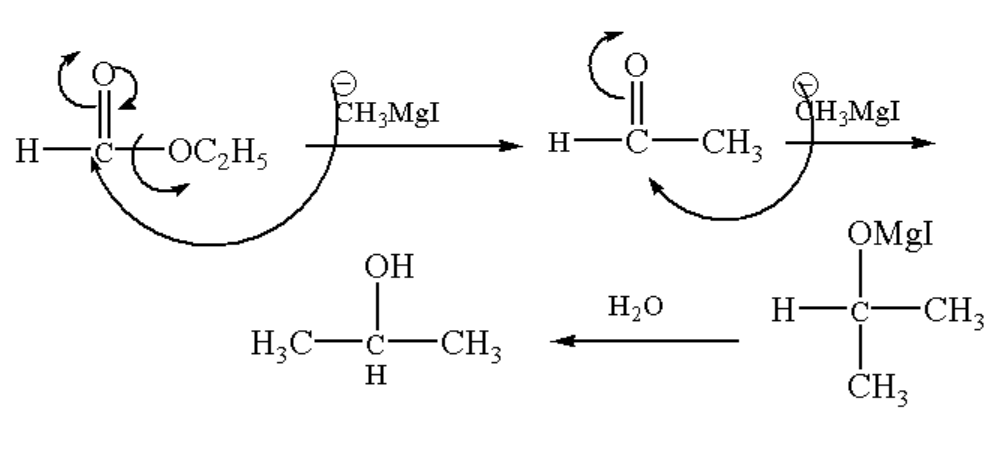
Reaction of ethyl formate with an excess of \[C{H_3}MgI\] followed by hydrolysis gives:
A. N-propyl alcohol
B. Isopropyl alcohol
C. Acetaldehyde
D. Acetone
Answer
220.5k+ views
Hint: Ethyl formate is an ester compound with chemical formula \[HCOO{C_2}{H_5}\]. Hydrolysis is a reaction which involves the addition of water.
Complete Step by Step Solution:
Ethyl formate is an ester compound produced by the reaction of alcohol and formic acid.
A Grignard reagent is a chemical compound with a general formula of \[RMgX\]. Here, R is the alkyl group and X is the halide group. It is an organomagnesium compound. The grignard reagent is formed by the reaction of aryl or alkyl halide with magnesium.
When Grignard reagent reacts with ethyl formate an intermediate product is formed which on hydrolysis leads to isopropyl alcohol.
First, the negative charge of the methyl group of Grignard reagent attacks the central carbon of ethyl formate and the ethyl group is removed, again the negative charge methyl group attack the carbon and an intermediate compound magnesium iodide propan-2-olate. The intermediate compound then undergoes hydrolysis which means the addition of a water molecule which results in the formation of the main product i.e, Isopropyl alcohol.
The reaction of ethyl formate with an excess of \[C{H_3}MgI\] followed by hydrolysis gives Isopropyl alcohol. Therefore, option B is correct.
The reaction mechanism is shown below.

Image: Formation of Isopropyl alcohol
Note: It should be noted that the ester compound needs two equivalent of a Grignard reagent to produce tertiary alcohol. On the other hand aldehyde and ketone requires one equivalent of Grignard reagent to form secondary alcohol and tertiary alcohol respectively.
Complete Step by Step Solution:
Ethyl formate is an ester compound produced by the reaction of alcohol and formic acid.
A Grignard reagent is a chemical compound with a general formula of \[RMgX\]. Here, R is the alkyl group and X is the halide group. It is an organomagnesium compound. The grignard reagent is formed by the reaction of aryl or alkyl halide with magnesium.
When Grignard reagent reacts with ethyl formate an intermediate product is formed which on hydrolysis leads to isopropyl alcohol.
First, the negative charge of the methyl group of Grignard reagent attacks the central carbon of ethyl formate and the ethyl group is removed, again the negative charge methyl group attack the carbon and an intermediate compound magnesium iodide propan-2-olate. The intermediate compound then undergoes hydrolysis which means the addition of a water molecule which results in the formation of the main product i.e, Isopropyl alcohol.
The reaction of ethyl formate with an excess of \[C{H_3}MgI\] followed by hydrolysis gives Isopropyl alcohol. Therefore, option B is correct.
The reaction mechanism is shown below.

Image: Formation of Isopropyl alcohol
Note: It should be noted that the ester compound needs two equivalent of a Grignard reagent to produce tertiary alcohol. On the other hand aldehyde and ketone requires one equivalent of Grignard reagent to form secondary alcohol and tertiary alcohol respectively.
Recently Updated Pages
Electricity and Magnetism Explained: Key Concepts & Applications

JEE Energetics Important Concepts and Tips for Exam Preparation

JEE Isolation, Preparation and Properties of Non-metals Important Concepts and Tips for Exam Preparation

JEE Main 2021 July 25 Shift 1 Question Paper with Answer Key

JEE Main 2021 July 22 Shift 2 Question Paper with Answer Key

States of Matter Chapter For JEE Main Chemistry

Trending doubts
JEE Main 2026: Application Form Open, Exam Dates, Syllabus, Eligibility & Question Papers

Derivation of Equation of Trajectory Explained for Students

Hybridisation in Chemistry – Concept, Types & Applications

Understanding the Angle of Deviation in a Prism

How to Convert a Galvanometer into an Ammeter or Voltmeter

JEE Main Marking Scheme 2026- Paper-Wise Marks Distribution and Negative Marking Details

Other Pages
NCERT Solutions For Class 11 Chemistry Chapter 7 Redox Reaction

JEE Advanced Marks vs Ranks 2025: Understanding Category-wise Qualifying Marks and Previous Year Cut-offs

Hydrocarbons Class 11 Chemistry Chapter 9 CBSE Notes - 2025-26

Thermodynamics Class 11 Chemistry Chapter 5 CBSE Notes - 2025-26

NCERT Solutions ForClass 11 Chemistry Chapter Chapter 5 Thermodynamics

Equilibrium Class 11 Chemistry Chapter 6 CBSE Notes - 2025-26




